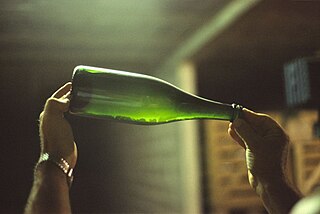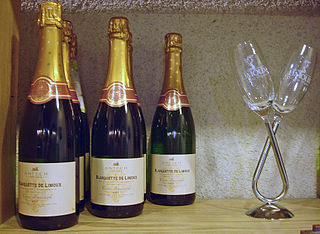
A gyropalette is a piece of equipment used in the production of sparkling wine, such as Champagne, made by the traditional method, where the second fermentation takes place in the bottle. [1] [2]

A gyropalette is a piece of equipment used in the production of sparkling wine, such as Champagne, made by the traditional method, where the second fermentation takes place in the bottle. [1] [2]
In order to remove the yeast sediment ("lees") left in the bottle after the fermentation, riddling (or in French remuage) is performed. At certain intervals, the bottle is twisted, shaken slightly and moved progressively to a vertical position with the neck pointing down. Traditionally, this used to take place manually over the course of several weeks, with wine cellar workers called remueurs performing the task on each individual bottle.
A gyropalette performs the same task automatically on many bottles at the same time, and in a shorter period of time. The bottles are placed in a cage, and are moved in a way which emulates the action of a remueur by means of motors and automatic controls.
The gyropalette was invented by two French vintners, Claude Cazals and Jacques Ducion, who filed for patent in 1968. [3] It was first introduced in Spain in the mid-1970s with Cava-producer Codorníu as the first big user. Most sparkling wines produced by the traditional method, including most Champagne, is now produced using gyropalettes. The manual method is still used for some high-end wines.

Champagne is a sparkling wine originated and produced in the Champagne wine region of France under the rules of the appellation, that demand specific vineyard practices, sourcing of grapes exclusively from designated places within it, specific grape-pressing methods and secondary fermentation of the wine in the bottle to cause carbonation.

Sparkling wine is a wine with significant levels of carbon dioxide in it, making it fizzy. While the phrase commonly refers to champagne, European Union countries legally reserve that term for products exclusively produced in the Champagne region of France. Sparkling wine is usually either white or rosé, but there are examples of red sparkling wines such as the Italian Brachetto, Bonarda and Lambrusco, and the Australian sparkling Shiraz. The sweetness of sparkling wine can range from very dry brut styles to sweeter doux varieties.

Dom Pierre Pérignon, O.S.B., was a French Benedictine monk who made important contributions to the production and quality of Champagne wine in an era when the region's wines were predominantly still red. Popular myths frequently, but erroneously, credit him with the invention of sparkling Champagne, which did not become the dominant style of Champagne until the mid-19th century.

A wine bottle is a bottle, generally a glass bottle, that is used for holding wine. Some wines are fermented in the bottle while others are bottled only after fermentation. Recently the bottle has become a standard unit of volume to describe sales in the wine industry, measuring 750 millilitres. Wine bottles are produced, however, in a variety of volumes and shapes.

Winemaking or vinification is the production of wine, starting with the selection of the fruit, its fermentation into alcohol, and the bottling of the finished liquid. The history of wine-making stretches over millennia. The science of wine and winemaking is known as oenology. A winemaker may also be called a vintner. The growing of grapes is viticulture and there are many varieties of grapes.

White wine is a wine that is fermented without skin contact. The colour can be straw-yellow, yellow-green, or yellow-gold. It is produced by the alcoholic fermentation of the non-coloured pulp of grapes, which may have a skin of any colour. White wine has existed for at least 4,000 years.

A rosé is a type of wine that incorporates some of the color from the grape skins, but not enough to qualify it as a red wine. It may be the oldest known type of wine, as it is the most straightforward to make with the skin contact method. The pink color can range from a pale "onionskin" orange to a vivid near-purple, depending on the grape varieties used and winemaking techniques. Usually, the wine is labelled rosé in French, Portuguese, and English-speaking countries, rosado in Spanish, or rosato in Italian.

Asti is a sparkling white Italian wine that is produced throughout southeastern Piedmont but is particularly focused around the towns of Asti and Alba. Since 1993 the wine has been classified as a Denominazione di Origine Controllata e Garantita (DOCG) and as of 2004 was Italy's largest producing appellation. On an average vintage more than ten times as much Asti is produced in Piedmont than the more well-known Piedmontese red wine Barolo.

Veuve Clicquot Ponsardin is a Champagne house founded in 1772 and based in Reims. It is one of the largest Champagne houses. Madame Clicquot is credited with major breakthroughs, creating the first known vintage champagne in 1810, and inventing the riddling table process to clarify champagne in 1816. In 1818, she invented the first known blended rosé champagne by blending still red and white wines, a process still used by the majority of champagne producers.
The glossary of wine terms lists the definitions of many general terms used within the wine industry. For terms specific to viticulture, winemaking, grape varieties, and wine tasting, see the topic specific list in the "See also" section below.

The traditional method is the process used in the Champagne region of France to produce Champagne. It is also the method used in various French regions to produce sparkling wines, in Spain to produce Cava, in Portugal to produce Espumante and in Italy to produce Franciacorta. The method is known as the méthode champenoise, but the Champagne producers have successfully lobbied the European Union to restrict the use of that term within the EU only to wines produced in Champagne. Thus, wines from elsewhere cannot use the term "méthode champenoise" on products sold in the EU, and instead the term "traditional method" or the local language equivalent. South African wines from the Western Cape are labelled with the term Methode Cap Classique. Some wine producers in countries outside the EU may disregard EU labeling laws and use méthode champenoise or even “Champagne” on labels for products not exported to the EU, but this usage is decreasing.

Sparkling wine production is the method of winemaking used to produce sparkling wine. The oldest known production of sparkling wine took place in 1531 with the ancestral method.

Limoux wine is produced around the city of Limoux in Languedoc in southwestern France. Limoux wine is produced under four Appellation d'origine contrôlée (AOC) designations: Blanquette de Limoux, Blanquette méthode ancestrale, Crémant de Limoux and Limoux, the first three of which are sparkling wines and dominate the production around Limoux. The main grape of the region is the Mauzac, locally known as Blanquette, followed by Chardonnay and Chenin blanc. In 2005, the Limoux AOC was created to include red wine production consisting of mostly Merlot. Wine historians believe that the world's first sparkling wine was produced in this region in 1531, by the monks at the abbey in Saint-Hilaire.
The classification of wine is based on various criteria including place of origin or appellation, vinification method and style, sweetness and vintage, and the grape variety or varieties used. Practices vary in different countries and regions of origin, and many practices have varied over time. Some classifications enjoy official protection by being part of the wine law in their country of origin, while others have been created by, for example, growers' organizations without such protection.

Cider is an alcoholic beverage made from the fermented juice of apples. Cider is widely available in the United Kingdom and the Republic of Ireland. The UK has the world's highest per capita consumption, as well as the largest cider-producing companies. Ciders from the South West of England are generally higher in alcoholic content. Cider is also popular in many Commonwealth countries, such as India, Canada, Australia, and New Zealand. As well as the UK and its former colonies, cider is popular in Portugal, France, Friuli, and northern Spain. Germany also has its own types of cider with Rhineland-Palatinate and Hesse producing a particularly tart version known as Apfelwein. In the U.S., varieties of fermented cider are often called hard cider to distinguish alcoholic cider from non-alcoholic apple cider or "sweet cider", also made from apples. In Canada, cider cannot contain less than 2.5% or over 13% absolute alcohol by volume.

The history of Champagne began when the Romans planted vineyards in this region of northeast France in the 5th century, or possibly earlier. Over centuries, Champagne evolved from being a pale, pinkish still wine to a sparkling wine. When Hugh Capet was crowned King of France in 987 at the cathedral of Reims, he started a tradition that brought successive monarchs to the region—with the local wine being on prominent display at the coronation banquets. The early wine of the Champagne region was a pale, pinkish wine made from Pinot noir.
This glossary of winemaking terms lists some of terms and definitions involved in making wine, fruit wine, and mead.
Cava is a sparkling wine of Denominación de Origen (DO) status from Spain. It may be white (blanco) or rosé (rosado). The Macabeo, Parellada and Xarel·lo are the most popular and traditional grape varieties for producing cava. Only wines produced in the traditional method may be labelled "cava"; those produced by other processes may only be called "sparkling wines". About 95% of all cava is produced in the Penedès area in Catalonia, Spain, with the village of Sant Sadurní d'Anoia being home to many of the largest Catalan production houses. The two major producers are Codorníu and Freixenet. Cava is also produced in other villages in Aragon, Castile and León, Extremadura, La Rioja, Basque Country, Navarre and Valencia.
Crémant de Luxembourg is a sparkling wine from Luxembourg's Moselle district made according to the traditional method of sparkling wine production which includes a second fermentation in the bottle followed by nine months of maturation. Only grapes from the best local varieties are used. They must be perfectly healthy, fully ripened, and free of damage from crushing or transportation.

English sparkling wine is sparkling wine from England, typically produced to the traditional method and mostly using the same varieties of grapes as used in Champagne – Chardonnay, Pinot noir and Pinot Meunier. English sparkling wine producers often employ Champagne terminology to describe the styles of their wine, such as "Classic Cuvée", "Blanc de Blancs" or "Demi-Sec".